Today’s Current Affairs: 16th May 2024 for UPSC IAS exams, State PSC exams, SSC CGL, State SSC, RRB, Railways, Banking Exam & IBPS, etc
Table of Contents
Wholesale Price Index:

Inflation in India’s wholesale prices rose to a 13-month high of 1.26% in April, owing to an uptick in food inflation and a 1.4% year-on-year rise in fuel and power prices after several months of deflation.
- Wholesale Price Index (WPI) measures the changes in the prices of goods sold and traded in bulk by wholesale businesses to other businesses.
- It is calculated and published by the Office of Economic Advisor, Department of Industrial Policy and Promotion in the Ministry of Commerce and Industry.
- WPI data is published monthly, with the index value representing an estimate of the price level for the month as a whole, rather than a specific date.
- Analysts use the numbers to track the supply and demand dynamics in industry, manufacturing, and construction.\
- An upward surge in the WPI indicates inflationary pressure in the economy, and vice versa.
- The quantum of rise in the WPI month-after-month is used to measure the level of wholesale inflation in the economy.
Chabahar Port:

India and Iran signed a 10-year contract on Monday for the operation of a terminal at the strategically important Chabahar port in Iran.
- The long-term bilateral contract was signed between Indian Ports Global Limited (IPGL) and the Port & Maritime Organisation (PMO) of Iran, enabling the operation of the Shahid Beheshti terminal at the Chabahar Port for 10 years.
- The pact replaces one-year contracts that were being signed to keep the port operational until now.
- Chabahar is a deep water port in Iran’s Sistan-Baluchistan province.
- It is the Iranian port that is the closest to India, and is located in the open sea, providing easy and secure access for large cargo ships.
- Modern Chabahar came into being in the 1970s, and Tehran realised the strategic importance of the port during the Iran-Iraq war of the 1980s.
- In January 2003, President Khatami and then Prime Minister Atal Bihari Vajpayee signed off on an ambitious roadmap of strategic cooperation.
- Among the key projects the two countries agreed on was Chabahar, which held the potential to link South Asia with the Persian Gulf, Afghanistan, Central Asia, and Europe.
- The timelines for the project were undone by India’s growing relationship with the United States.
- The US, which declared Iran as one of the “axis of evil” along with Iraq and North Korea, pushed New Delhi to abandon its strategic relationship with Tehran, and the Chabahar project became a casualty.
- While India spent about $100 million to construct a 218-km road from Delaram in western Afghanistan to Zaranj on the Iran-Afghan border to link with Chabahar, the port project itself progressed at a glacial pace.
- IPGL (India Ports Global Ltd) has been operating Chabahar port through its wholly owned subsidiary, India Ports Global Chabahar Free Zone (IPGCFZ), since December 24, 2018.
- The port has handled more than 90,000 twenty-foot-equivalent units (TEUs) of container traffic and more than 8.4 million metric tonnes (MMT) of bulk and general cargo since then.
BHISHM Portable Cubes:

BHISHM portable cubes were dropped from an airplane by the Indian Air Force in Agra as part of an important test. These mobile hospitals are meant to provide emergency medical care anywhere, and this event was their first test run.
- Project BHISHM, which stands for “Bharat Health Initiative for Sahyog, Hita, and Maitri,” involves putting up mobile hospital units that can treat up to 200 people at once. The goal of this effort is to respond quickly and provide complete care in emergencies.
- Features of BHISHM Portable Cubes:
- Aid Cubes come with cutting-edge technology, like Artificial Intelligence (AI) and data analytics, that will change the way crisis relief is done forever.
- Using AI and data analytics in Aid Cubes makes it easier for disaster response teams to work together, making sure that aid efforts are coordinated and done on time.
- These movable cubes are made to improve medical care in the field, which is especially important after disasters.
- AI and data analytics make it possible to keep an eye on resources and people in real time, which improves the performance of medical and aid services.
- Aid Cubes allow continuous, real-time tracking of the situation on the ground.
- This lets people make quick changes and smart decisions when things are changing quickly.
- The technology in Aid Cubes makes it easier for teams and agencies working on crisis relief to talk to each other and work together, which makes operations run more smoothly and efficiently
High Energy Photon Source:
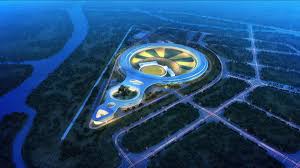
China is set to become the first country in Asia with a fourth-generation synchrotron light source with the completion of the High Energy Photon Source (HEPS).
- This advanced facility will produce some of the world’s brightest X-rays, significantly enhancing research capabilities across various scientific fields.
- HEPS will accelerate electrons to 6 gigaelectron volts, enabling high-resolution imaging at nanometre scales and facilitating rapid experiments.
- HEPS (High Energy Photon Source) is recognized as the brightest synchrotron X-ray source in Asia.
- Synchrotrons use electricity to generate intense beams of light, over a million times brighter than the sun.
- They utilize a multi-bend achromat lattice, a complex array of magnets, to produce narrower and brighter X-ray beams.
Nancy Grace Roman Telescope:
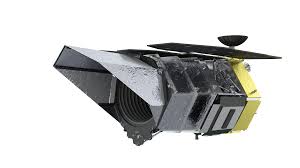
NASA’s upcoming Nancy Grace Roman Space Telescope, set to launch in late 2026, will search for tiny primordial black holes dating back to the Big Bang.
- These hypothetical black holes, with masses similar to Earth or even large asteroids, could revolutionize theoretical physics if detected
- Detection of these small black holes, which would be impossible to form by any known process, would utilize gravitational lensing, where the black holes bend light from distant sources.
- This technique, currently used to find rogue planets, will help differentiate between these black holes and other objects statistically.
- Confirming their existence would have profound implications for understanding galaxy formation, dark matter, and cosmic history, challenging Stephen Hawking’s theory that smaller black holes should have evaporated through Hawking radiation over 13.8 billion years.
First Bank To Become a Trading Cum Clearing (TCM) Member:
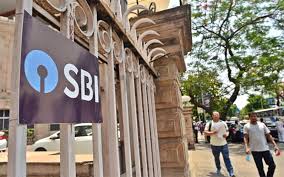
State Bank of India (SBI) announced that it has become the first bank to become a Trading cum Clearing (TCM) Member at India International Bullion Exchange (IIBX).
- It enables SBI’s IFSC Banking Unit (IBU) to trade on the IIBX platform as the RBI allowed IBUs to act as trading members and clearing members at IIBX as Special Category Clients (SCCs) for importing gold through the bullion exchange.
- This move is expected to increase trading volumes for gold and silver at the IIBX, bringing transparency and efficiency to India’s Bullion Market.
- IIBX regulated by the International Financial Services Centers Authority (IFSCA) is India’s first bullion exchange established in GIFT -City IFSC.
- A bullion market is where traders trade in precious metals like gold and silver, with exchanges taking place directly between buyers and sellers and in the futures market (auction market).
- The versatile uses of silver and gold, especially in industrial applications, influence their prices. Bullions are considered a safe bet against inflation and a haven for investment.
- TCM is a member who can trade on their own account and on behalf of their clients, and also clear and settle trades executed by themselves and other trading members who opt to use their clearing services.
UNESCO’s Memory Of The World Asia-Pacific Regional Register:
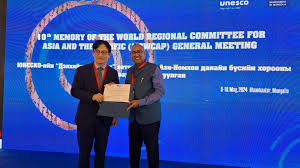
The Ramcharitmanas, Panchatantra, and Sahṛdayāloka-Locana have been included in ‘UNESCO’s Memory of the World Asia-Pacific Regional Register’.
- ‘Sahṛdayaloka-Locana’, ‘Panchatantra’, and ‘Ramcharitmanas’ were authored by Acharya Anandvardhan, Pt. Vishnu Sharma, and Goswami Tulsidas, respectively.
- The Indira Gandhi National Centre for the Arts (IGNCA) played a vital role in securing the historic moment during the 10th meeting of the Memory of the World Committee for Asia and the Pacific (MOWCAP).
- This marks the first time IGNCA has submitted nominations to the Regional Register since its inception in 2008.
- The Memory of the World (MoW) Program is a global initiative launched by UNESCO in 1992 to safeguard important documentary heritage.
- In the Asia Pacific region, a specific branch called the Memory of the World Committee for Asia and the Pacific (MOWCAP) was established in 1998.
- MOWCAP covers 43 countries, representing one of UNESCO’s five regional programs.
UN Financing For Sustainable Development Report 2024:

A new report released by the United Nations (UN) stated that more investment is needed if the 17 Sustainable Development Goals (SDGs), agreed upon by all United Nations members back in 2015, are to be achieved by 2030.
- The reason for this situation is due to staggering debt burdens and sky-high borrowing costs faced by developing countries that prevent them from responding to the confluence of crises they face.
Key Highlights of UN Financing for Sustainable Development Report 2024:
- Rising geopolitical tensions, climate disasters and a global cost-of-living crisis have hit billions of people globally, which has halted the progress on healthcare, education, and other development targets.
- Debt services in the Least developed countries (LDC) will increase from USD 26 billion annually in 2022 to USD 40 billion annually between 2023 and 2025.
- Stronger and more frequent disasters, caused by the ongoing climate crisis, account for more than half of the debt upsurge in vulnerable countries.
- The poorest countries now spend 12% of their revenues on interest payments, 4 times more than they spent a decade ago.
- Roughly 40% of the global population live in countries where governments spend more on interest payments than on education or health.
- In Least developed countries, development fundings are slowing down.
- Due to several reasons such as low domestic revenue growth due to tax evasion and avoidance, falling rate of corporate tax (which was 28.2% in 2000 to 21.1% in 2023), due to globalisation and tax competition etc.
- Also, Official Development Assistance (ODA) from OECD countries and climate finance commitments are not being met.
- According to the Financing for Sustainable Development Report: Financing for Development at a Crossroads Report 2024, around USD 4.2 trillion investments is needed to close the development financing gap.
- This number was USD 2.5 trillion before the Covid-19 pandemic began.
Exercise Tarkash:
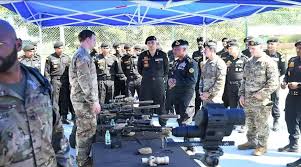
The India-U.S joint exercise in conducting coordinated operations in urban counter terrorism contingencies will conclude in Kolkata.
- Exercise Tarkash is the seventh edition of the Indo-U.S. joint counter terrorism exercise.
- It is held between the elite National Security Guard (NSG) and the U.S. Special Operations Forces (SOF) commenced on April 22, 2024.
- The primary objective of the bilateral exercise is to build functional relation and enhance interoperability between the two special forces in conducting coordinated counter terror operations in urban counter terrorism contingencies.
- It is also aimed at improving bilateral cooperation between India and the U.S. in matters relating to combating terrorism, in all its forms and manifestations,” a statement said.
- It also involved sharing of best practices, tactics, techniques and procedures, over a wide spectrum of counter terror operations, in urban environment including close quarter battle, building intervention drills and hostage rescue operations etc.
Geomagnetic Storms : Hits Earth

The strongest geomagnetic storm in over two decades recently hit Earth, causing radio blackouts and extending the northern lights to the southern United States.
- Geomagnetic Storm is a major disturbance of Earth’s magnetosphere that occurs when there is a very efficient exchange of energy from the solar wind into the space environment surrounding Earth.
- These storms result from variations in the solar wind that produce major changes in the currents, plasmas, and fields in Earth’s magnetosphere.
- The solar wind conditions that are effective for creating geomagnetic storms are sustained (for several hours) periods of the high-speed solar wind and a southward-directed solar wind magnetic field (opposite the direction of Earth’s field) at the dayside of the magnetosphere.
- The largest such storms are associated with solar coronal mass ejections (CMEs), where a billion tons or so of plasma from the sun, with its embedded magnetic field, arrives at Earth.
- It results in intense currents in the magnetosphere, changes in the radiation belts, and changes in the ionosphere, including heating the ionosphere and an upper atmosphere region called the thermosphere.
- These storms can heat the ionosphere, causing beautiful auroras on earth.
- Because the ionosphere is heated and distorted during storms, long-range radio communication that relies on sub-ionospheric reflection gets affected.
- Ionospheric expansion due to these storms can increase satellite drag and make their orbits difficult to control.
- Satellite electronics can be damaged through the buildup and discharge of static-electric charges.
- It can disrupt global navigation systems.
- It can create harmful geomagnetic-induced currents (GICs) in the power grid and pipelines.




